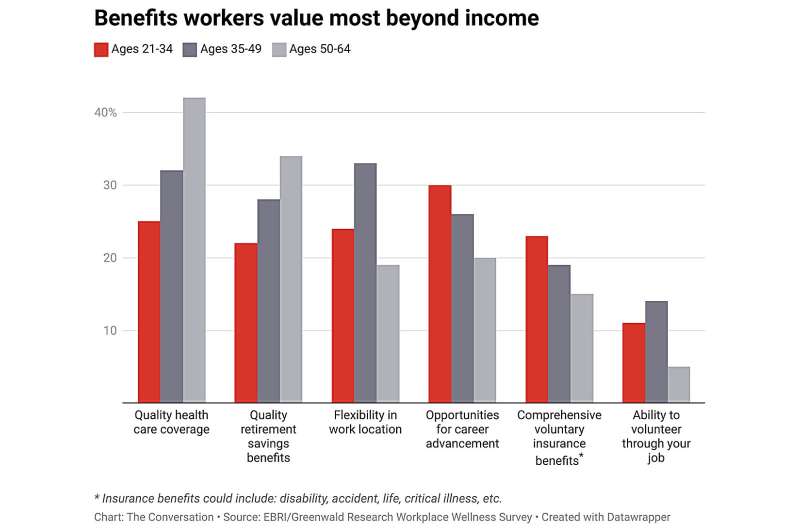This article has been reviewed according to Science X's editorial process and policies. Editors have highlighted the following attributes while ensuring the content's credibility:
fact-checked
trusted source
written by researcher(s)
proofread
Generous perks equals happy workers? Not always. Here's what employees really want

Many Australian companies offer a range of benefits and perks to workers, hoping to attract top talent and strengthen employee loyalty.
These might include a work car, free lunches, generous overtime, gym memberships, flexible hours, extra holidays, subsidized childcare, professional development and health insurance.
Work perks are on top of pay and are often available irrespective of an employee's performance.
Some employers even go as far as paying for fertility treatments such as IVF and egg freezing. This has been big for a decade in the United States, where such support is available at Facebook, LinkedIn, Google and Amazon.
While Australian companies have been slower to adopt fertility-related perks, one local business, Virtus Health, a fertility treatment center, offers staff free access to its egg freezing program.
What employers really need to provide
A job with assorted incentives sounds appealing. But what kinds of benefits actually support employees, and thereby employers? You might think the larger the package, the happier the worker—but this isn't necessarily the case.
There is no clear evidence employees' satisfaction is highly correlated with the size of the benefits package.
Rather, research suggests employee benefits are most effective when they generate "positive social exchange relationships" between employers and employees.
A positive social exchange relationship develops when employees believe the benefits are special gifts from their employer, and thereby reciprocate with extra effort and loyalty to the organization.
Which perks actually work?
So what kinds of perks and benefits are likely to generate such relationships?
My research, in collaboration with Patrick Wright of the University of South Carolina, suggests that for a firm's management to generate a positive employer-employee relationship, it should go beyond what's required by regulations and cultural norms.
Employee packages generally consist of two major components: benefits mandated by laws and norms, and discretionary perks that organizations voluntarily provide.
The latter, voluntary category is what really counts in employees' minds when considering how much goodwill their employer is expressing.
For instance, Australian workers are legally entitled to receive an 11% employer contribution to superannuation, the Australian version of retirement funds.
This means employees don't have reason to feel grateful to their employer because the contribution is legislated. If a company wants to attract and engage talent, it should consider making a more generous contribution above the legislated rate.
Benefits employees appreciate
Another condition for benefits to generate a positive employee–employer relationship is workers should consider them valuable.
For many workers in the US, where health care is highly privatized, joining a company with strong health benefits is their top priority. This is crucial for employees who may otherwise find health care unaffordable.
Employees' preferences for benefits could be shaped by events in wider society.
Since the COVID pandemic, studies suggest employees give more weight to flexible work arrangements and mental health support.
Demographics also determine the type of benefit employees want.
Women have traditionally placed more value than men on flexible work arrangements, as it helps reduce tensions between work and family responsibilities.
Studies have also shown that employees of different generations may prefer different benefits.
For instance, younger workers give more value to professional development programs that could help their career advancement.
They also value help with their day-to-day expenses, and with paying off student loans. As might be expected, older workers value more health-related and retirement savings benefits.
Workplace-related benefits
Ideally, an effective benefit should be specific to the company, so employees can enjoy it only by joining and staying with that organization.
If an employee can easily receive the same or similar benefits by moving to another employer, it may not work as a retention strategy.
Firm-specific benefits are particularly effective when they are based on a company's unique resources and capabilities.
For instance, an employee of an international airline might be eligible for substantially discounted flights. These benefits cost the company little, while giving employees an incentive to stay.
Implementation matters
Employee benefits will work for employees and employers when they exceed expectations, meet workers' needs, and reflect a company's unique capabilities.
To have maximum impact, they need to be well communicated to all workers. But in many organizations, employees feel they do not have the same opportunities as their peers to receive employer-provided benefits.
For perks and benefits to attract top staff and engender workplace loyalty, employees need to feel they are being treated fairly by having equal access to information about what's available and to the benefits themselves.
Employees will feel supported by well-managed schemes.
But if they think the system lacks organizational justice, the perceived or actual satisfaction with benefits is undermined.
Provided by The Conversation
This article is republished from The Conversation under a Creative Commons license. Read the original article.![]()



















